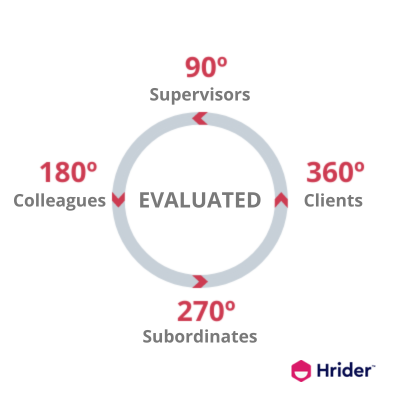In the professional performance evaluation we constantly deal with strange nomenclatures that do not make it easier to understand the process and that, more than helping us, sometimes confuse us. For this reason, in this post we are going to try to explain what the different work performance evaluation methodologies based on the different roles that interact are. We hope to help you choose those options that best fit each organization.

90º Performance assessment
In a 90-degree performance evaluation, it is the Supervisor who makes the assessment of the employee.
What our manager thinks of our work is essential for carrying out the tasks that he or she has entrusted to us. He is in charge of articulating the mechanisms that will guide our professional Career Plan and, in addition, he is the person who will give us the necessary feedback to know our strengths and weaknesses. His vision is very important, but... is it the only one?
180º performance assessment
In a 180 degree evaluation, Peers also intervene as evaluators of an employee.
Many times our boss knows us based on how we behave with us or based on the final result of our work, but on a day-to-day basis we share responsibilities, opinions, information and ways of doing things with our colleagues (Peer review). They, who share similar tasks and objectives, can also provide us with valuable opinions about what we do very well and what we should do our part to improve.
270º Performance assessment
In a 270-degree performance evaluation, Subordinates (people in charge of a team leader) give their assessment of how their Supervisor carries out their activity.
Giving an opinion about our Boss (Upward review) is something we informally do all the time and even share with numerous members of our organization, isn't it? But if, through a formal mechanism, we offer a constructive and respectful vision, it is something that will not only help our Supervisor, but can also help us improve our professional relationship. Of course, we can also make this process anonymous, so that the team can express their assessment comfortably.
For senior management, knowing the opinion of our middle management employees will help us to promote those leadership styles that are most successful and detect problems without them getting stuck at the supervisory level.
360º feedback
In a 360-degree methodology professional performance assessment, we seek a comprehensive vision of all those who interact with a professional: Boss, Colleagues, Subordinates and, also Clients and/or Suppliers
Calculating the degree of performance of behavior is more subjective than calculating the degree of achievement of a sales objective, for example, in which reaching the required level is dictated by a number.
How to reach an objective conclusion when the variables we measure are, to a large extent, subjective?: the more subjective samples we have, the more objective the final result we obtain will be.
Imagine the power that knowing what clients think of our work can give an organization!
Our goal is to work better for them every day, why not give them the floor so they can guide us to take the right path?
We must remember that we not only work with clients external to our organization, we often work for other areas of the company: they will be our "internal clients" and can also assess how we perform our tasks.

Self-assessment
The employee's own vision of their work is something that remains at the center of the job performance evaluation process. In addition to being able to have a 360-degree perspective of what surrounds the professional, we must consider inviting them to reflect and give their vision. At Hrider self-assessment It seems to us a highly recommended exercise that brings great benefits to the process. Plus, it's one of the best gifts that you can offer to an employee for the development of their Career Plan.
Depending on the type of indicators we are measuring, we can determine which roles are the most appropriate to measure them.
Of course, we can choose different methodologies depending on each job position. Perhaps it is important that we know the vision that a team has of its Director (270º) and, on the other hand, for a Customer Service Manager the most interesting thing is to have feedback from the clients themselves (360º).
On the other hand, if what we evaluate are Numerical KPIs, it will not be necessary to have the technique of multiple perspectives, because if we associate the achievement with a certain number of clients achieved, or with the number of projects executed, the answer is unique and you don't need subjective interpretations to compare.
The fundamental thing is to know what our objective is when launching our work performance evaluation processes. We should not worry about the complexity of dealing with one or the other model, because with a system like Hrider we can automate this management obtaining results in real time and without the need to dedicate time to bureaucratic procedures ;-)
If you want to know more, in this post we explain how to do a step-by-step performance evaluation.